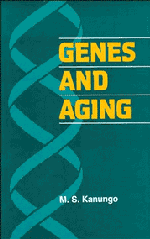2 - Phenotypic changes during aging
Published online by Cambridge University Press: 22 March 2010
Summary
The genome in a eukaryote houses far more DNA and genes than it needs for its various functions. This is the inference one draws if one counts the various types of enzymes, structural proteins, mRNAs, tRNAs, and rRNAs that are coded by the genome. Only 3%–5% of the genome accounts for these molecules. Of the remaining, nearly 40% comprise repetitive DNA whose exact function is not known. What the rest of the DNA does is not known. Assuming that it is only the expressed fraction of the DNA or genes that plays a role in the aging process or holds the key to the aging process of an organism, one may look for changes that occur in this fraction during its life span, and hope to find a common pattern of changes in specific sets of genes. Such a finding may give an insight into the possible causes of aging since genes have been implicated in the following fixed-time life processes of mammals: gestation, attainment of maturity and growth completion, duration of reproduction and fertility, life span, and body size. These times may vary with the species of mammals. The variations seen in these characteristics among individuals within a species have been attributed to various extrinsic factors such as nutrition, temperature, radiation, and stress.
Biochemical research on aging commenced in the early 1950s. Until about 1970 the research was confined to mostly studies on changes in enzymes and structural proteins. It had two purposes: First, since enzymes catalyze all functions of the body, an understanding of their changes during the life span may throw light on the aging process.
Information
- Type
- Chapter
- Information
- Genes and Aging , pp. 21 - 54Publisher: Cambridge University PressPrint publication year: 1994
